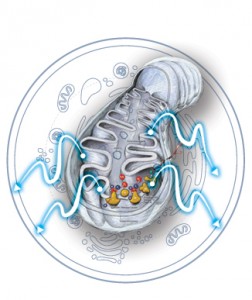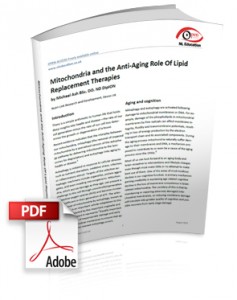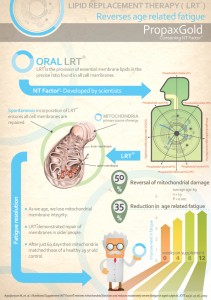 Introduction
Introduction
There is a simple arithmetic to human life that holds deep insights into health and disease—the rate of our cell generation minus the rate of our cell loss determines the growth or degeneration of a tissue.
Recent evidence indicates that the interplay between our mitochondria, mitophagy (the removal of impaired mitochondria by a specialised version of the autophagy pathway by delivering mitochondria to the lysosomes for degradation) and autophagy links aging to health or disease.[1]
Autophagy is initiated in response to cellular stresses such as nutrient starvation, oxidative stress, infection, or inflammatory stimuli. Targets of the selective autophagic machinery include organelles, protein aggregates, and even invading microorganisms. Mitochondria, which accrue damage as they age, can present a challenge to the cell through uncontrolled generation of reactive oxygen species (ROS) and become increasingly inefficient in their generation of adenosine triphosphate (ATP).
The selective removal of mitochondria by autophagy, known as mitophagy, is an important cellular adaptation to the challenge presented by this important organelle and the potential health hazard it represents.[2] Equally important is the prevention of inappropriate damage and the related early repair of mitochondrial membranes to ensure that appropriate and time relevant mitophagy occurs.
Aging and cognition
 Mitophagy and autophagy are activated following damage to mitochondrial membranes or DNA. For example, damage of the phospholipids in mitochondrial membranes by free radicals can affect membrane integrity, fluidity and transmembrane potentials, resulting in loss of energy production by the electron transport chain and its associated components. During the aging process, mitochondria naturally suffer damage to their membranes and DNA, a mechanism proposed to contribute to, or even be a cause of the aging process since the 1950s.[3]
Mitophagy and autophagy are activated following damage to mitochondrial membranes or DNA. For example, damage of the phospholipids in mitochondrial membranes by free radicals can affect membrane integrity, fluidity and transmembrane potentials, resulting in loss of energy production by the electron transport chain and its associated components. During the aging process, mitochondria naturally suffer damage to their membranes and DNA, a mechanism proposed to contribute to, or even be a cause of the aging process since the 1950s.[3]
Most of us can look forward to an aging body and brain receptive to interventions and lifestyle changes even though most make little or no attempt to make best use of them. One of the areas of significant, insidious decline, is our cognitive function.
A primary mechanism gaining increasing credibility in explaining age related cognitive decline, is the loss of membrane competence in brain related mitochondria. The corollary of this, is that by maintaining or repairing adversely damaged mitochondrial membranes, therefore reducing membrane damage, will translate into greater quality of cognition and possible recovery from early stage damage.
Mitochondrial membrane repair
One method that has been used to replace damaged mitochondrial membrane phospholipids is Lipid Replacement Therapy (LRT®). This has been accomplished, in part, by replacement of damaged lipids using a dietary supplement containing polyunsaturated phosphatidylcholines and other phospholipids and fatty acids that mimic essential structural and functional components of all biological membranes.[4]
There are at least three major mechanisms through which mitochondria can compromise, damage or kill their host, namely through production of reactive oxygen and nitrogenous species or pro-inflammatory signals or through mitochondrial membrane permeabilisation.
ROS/RNS
Mitochondria are both generators of and targets for reactive species. Mitochondria generate ROS from a number of different redox centres in the respiratory chain and other metabolic pathways. Reactive nitrogen species (RNS) are less concentrated but also contribute to loss of membrane quality and diminish functionality. Importantly, the majority of free radicals are generated inside the cell rather than being generated from the environment.
Therefore oxidative stress is inseparably linked to mitochondrial dysfunction.
While mitochondria perform essential functions for the cell, notably ATP production via oxidative phosphorylation, haeme biosynthesis, and calcium homeostasis, their continued existence within the cell may sometimes seem like a pact with the devil. On their dark side, mitochondrial dysfunction is a key factor in a myriad of diseases, including neurodegenerative and metabolic disorders.[5],[6] It has also recently been proposed that it may also have a role to play in the development and resolutions of autism.[7]
The first outward symptom of cellular deterioration may be fatigue both physical and mental. As the phospholipid structure of the mitochondrial membrane loses fluidity and becomes more porous at lipid/protein interfaces in the membrane, the membrane potential is affected and less able to maintain the energy delivering electron transport process. In addition, the electron transport chain increases the production of ROS/NOS free radicals that can further damage mitochondrial membranes and mitochondrial DNA (mtDNA). Although there is always some inherent mitochondrial membrane leakage and damage, this is usually repaired as part of our complex homeostatic mechanism, unless the rate of repair is exceeded by the rate of oxidative damage.
Yes – even when mitochondria are functionally normal, 1–2% of the oxygen they consume is converted to the ROS superoxide and then to hydrogen peroxide. Just as cars emit smog even when idling, mitochondria produce small amounts of superoxide even when ATP production is minimal.
Damaged but still functional mitochondria, might release up to tenfold more hydrogen peroxide.[8] These are potent oxidants and their neutralisation has been the classic route for mitochondrial management proposed for the benefits linked to food and supplementation choice. It is well understood that mitochondria are able to destroy these internally produced free radicals using vitamin E, ascorbate, coenzyme Q 10, cytochrome c and glutathione or enzymatically with superoxide dismutase, glutathione peroxidase and catalase.
Isolated antioxidants have limited benefits!
Yet oral supplementation of these and other antioxidants alone has proved to be inconclusive in terms of improved membrane functionality; it is possible that the antioxidants do not reach the sites of free-radical generation, especially when mitochondria are the primary source of ROS/NOS. Contemporary recommendations utilise a different strategy aimed at stabilising cellular and mitochondrial structures (inner and outer membranes), improvement of the efficiency of energy production, efficacious exogenous antioxidant supplementation and the improvement of endogenous antioxidant production.[9]
Anti-Aging Strategies
Reduction of age related mitochondrial decline via oral ingestion of supplementary antioxidants has a somewhat chequered history; it is hard to find unequivocally supportive evidence of related improvements in longevity and mitochondrial benefit. In some cases it appears that ingestion of antioxidants may act to actually promote oxidative stress rather than oxidative resolution. Whether an antioxidant functions as an antioxidant or pro-oxidant is determined by at least 3 factors9:
- The redox potential of the cellular environment
- The presence/absence of transition metals
- The local concentrations of that antioxidant
Utilising nutrients to keep the mitochondrial membranes, espescially the phospholipid components, intact and highly functioning is the area of interest for researchers involved in the development of membrane matching lipid replacement therapy for preventing age related decline. By repairing damaged membranes, and preventing inappropriate membrane permeability and subsequent collapse, LRT® confers a unique advantage to the patient over that delivered simply through oral food and supplement ingestion; the membranes composed of phospholipids with proteins embedded in them can be improved, restored and repaired permitting better molecular transport, increased ATP and diminished oxidative stress.[10] The delivery of unoxidised cellular membrane specific lipids can help to ensure proper function of cellular and organelle membranes.
It is “self-evident” in some ways, disease is caused by a loss of organisation—by entropy—which is essentially a loss of energy.
Mental mitochondria – should we just starve them?
The brain has an abundance of mitochondria as brain cells are a major site of generation and action of ROS/RNS. The brain uses 20% of the inspired oxygen and 90% of the consumed oxygen to produce energy during oxidative phosphorylation. The neuronal cells are thus particularly sensitive to oxidative stress and therefore make excellent targets for mitochondrial repair and reduction of energy sapping membrane permealisation.[11]
Mitochondrial turnover is, as already described, dependent on the balanced interplay between autophagy and mitophagy.[12] These elaborately linked homeostatic elements act in response to changes in cellular environment such as energy, nutrient availability, and stress.[13] The most universal stressor to induce autophagy is starvation; the net result is that caloric restriction ensures excellent mitochondrial function and aging by promoting mitochondrial turnover.[14] A similar mechanism is observed with exercise.[15] ,[16]
Mitophagy provides some neurological related focus as it eliminates the subset of mitochondria producing the most reactive oxygen species, and this episodic removal of mitochondria will reduce the oxidative burden, thus linking the mitochondrial free radical theory of aging with longevity achieved through caloric restriction.[17]
Mitophagy must of course be balanced by biogenesis to meet tissue energy needs, but the system is tuneable and highly dynamic. This process is of greatest importance in long-lived cells such as cardiomyocytes, neurons, and memory T cells. Autophagy and mitophagy are known to decrease with age, and the failure to maintain mitochondrial quality control through suitable mitophagy may explain why the heart, brain, and components of the immune system are most vulnerable to dysfunction as we age. Repairing and preventing inappropriate permealisation in mitochondria as we age through the ingestion of LRT®, improved diet, moderate exercise and caloric restriction represents a compelling combination of evidence based therapies suitable for practical application.
As mitochondria age, they become progressively inefficient and potentially toxic, and any acute damage can trigger the permeabilisation of mitochondrial membranes to initiate apoptosis or necrosis. [18]However, aging also brings with it a loss of motivation and compression of time – the consumption of LRT® as a substantive intervention for the mediation and recovery of age related mitochondrial damage is an attractive single point of treatment; safe, effective and easy to use.
Feed mitochondria fats to make them younger

One method that has been successfully used to replace damaged and aging mitochondrial and cellular membrane phospholipids is lipid replacement therapy, accomplished, in part, by replacement of damaged lipids using a dietary supplement containing polyunsaturated phosphatidylcholines and other phospholipids and fatty acids that are essential structural and functional components of all biological membranes.[19],4,[20]
Evidence
An innovative research study was conducted on a group of aged subjects (mean age= 68.9±4.18) using an LRT® product containing the patent pending membrane specific lipid complex known commercially as NT Factor™.
Results were analysed using a validated questionnaire (Piper Fatigue Scale) and mitochondrial assessment via analysis of Rhodamine-123 transport and reduction.[21],[22] Among those who were moderately fatigued, supplementation with LRT® reduced fatigue by 20% after 4 weeks, by 33% after 8 weeks, and by 35% after 12 weeks. Among the moderately fatigued, the function of mitochondria was improved by 15 % after 4 weeks, and by 26% after 8 weeks respectively More impressively, the mitochondrial functionality of the aged group was restored to the same level of function as that displayed by the healthy 29 year old control- effectively mitochondrial function was restored to levels similar to those found in young adults.19
The use of LRT® returned the health of the membranes, in the case of the seventy-year-old study participants, to a level of vitality, integrity and function of more than half a lifetime earlier, indicating a successful healthy aging strategy.
Conclusion
The implications in this study and multiple other studies using LRT® and NTFactor™ is that cellular membranes may be rejuvenated and protected against inappropriate damage induced autophagy and mitophagy, energy management may be improved and age related declines linked to abnormal mitochondrial function reversed or compressed using a mixture of membrane specific orally delivered glycophospholipids.
The symptomatic gains relate to improved neuronal health, improved ATP production and suppression of oxidative stress – a compelling mix of beneficial effects.
References
[1] Green DR, Galluzzi L, Kroemer G. Mitochondria and the autophagy-inflammation-cell death axis in organismal aging. Science. 2011 Aug 26;333(6046):1109-12. Review. View Abstract
[2] May AI, Devenish RJ, Prescott M. The many faces of mitochondrial autophagy: making sense of contrasting observations in recent research. Int J Cell Biol. 2012;2012:431684. Epub 2012 Apr 8. View Abstract
[3] Harman D. Aging: A theory based on free radical and radiation chemistry. J Gerontol. 1956; 2: 298-300. View Abstract
[4] Colodny L, Lynch K, Farber C, Papish S, et al. Results of a study to evaluate the use of Propax to reduce adverse effects of chemotherapy. JANA 2000; 2: 17-25. View Full Paper
[5] Nunnari J, Suomalainen A. Mitochondria: in sickness and in health. Cell. 2012 Mar 16;148(6):1145-59. Review. View Abstract
[6] Karbowski M, Neutzner A. Neurodegeneration as a consequence of failed mitochondrial maintenance. Acta Neuropathol. 2012 Feb;123(2):157-71. Epub 2011 Dec 7. Review. View Abstract
[7] Rossignol DA, Frye RE. A review of research trends in physiological abnormalities in autism spectrum disorders: immune dysregulation, inflammation, oxidative stress, mitochondrial dysfunction and environmental toxicant exposures. Mol Psychiatry. 2012 Apr;17(4):389-401. doi: 10.1038/mp.2011.165. Epub 2011 Dec 6. View Abstract
[8] Grivennikova VG, Kareyeva AV, Vinogradov AD. What are the sources of hydrogen peroxide production by heart mitochondria? Biochim Biophys Acta. 2010 Jun-Jul;1797(6-7):939-44. Epub 2010 Feb 17. View Abstract
[9] Poljsak B. Strategies for reducing or preventing the generation of oxidative stress. Oxid Med Cell Longev. 2011;2011:194586. Epub 2011 Dec 10. Review. View Abstract
[10] Nicolson GL, Ellithorpe RR, Ayson-Mitchell, C Settineri RA, Lipid replacement therapy with a gltcophospholipid –antioxidant-vitamin formulation significantly reduces fatigue within one week, Journal of the American Nutraceutical Association 2010; 13(1):11-15. View Full Paper
[11] Batlevi Y, La Spada AR. Mitochondrial autophagy in neural function, neurodegenerative disease, neuron cell death, and aging. Neurobiol Dis. 2011 Jul;43(1):46-51. Epub 2010 Sep 29. Review. View Abstract
[12] Novak I. Mitophagy: a complex mechanism of mitochondrial removal. Antioxid Redox Signal. 2012 Sep 1;17(5):794-802. Epub 2012 Feb 3. View Abstract
[13] Okamoto K, Kondo-Okamoto N. Mitochondria and autophagy: Critical interplay between the two homeostats. Biochim Biophys Acta. 2012 May;1820(5):595-600. Epub 2011 Aug 7. View Abstract
[14] Haigis MC, Guarente LP. Mammalian sirtuins–emerging roles in physiology, aging, and calorie restriction. Genes Dev. 2006 Nov 1;20(21):2913-21. Review. View Abstract
[15] Little JP, Safdar A, Cermak N, Tarnopolsky MA, Gibala MJ. Acute endurance exercise increases the nuclear abundance of PGC-1alpha in trained human skeletal muscle. Am J Physiol Regul Integr Comp Physiol. 2010 Apr;298(4):R912-7. Epub 2010 Jan 27. View Abstract
[16] Corbi G, Conti V, Scapagnini G, Filippelli A, Ferrara N. Role of sirtuins, calorie restriction and physical activity in aging. Front Biosci (Elite Ed). 2012 Jan 1;4:768-78. Review. View Abstract
[17] Lee IH, Cao L, Mostoslavsky R, Lombard DB, Liu J, Bruns NE, Tsokos M, Alt FW, Finkel T. A role for the NAD-dependent deacetylase Sirt1 in the regulation of autophagy. Proc Natl Acad Sci U S A. 2008 Mar 4;105(9):3374-9. Epub 2008 Feb 22. View Abstract
[18] Green DR, Galluzzi L, Kroemer G. Mitochondria and the autophagy-inflammation-cell death axis in organismal aging. Science. 2011 Aug 26;333(6046):1109-12. Review. View Abstract
[19] Agadjanyan M, Vasilevko V, Ghochikyan V, et al, Nutritional Supplement (NT Factor™) Restores Mitochondrial Function and Reduces Moderately Severe Fatigue in Aged Subjects, Journal of Chronic Fatigue Syndrome 2003 Jan; 11(3):23-36. View Full Paper
[20] Seidman M, Khan MJ, Tang WX, Quirk WS. Influence of lecithin on mitochondrial DNA and age-related hearing loss. Otolaryngol Head Neck Surg 2002; 127:138-144.
[21] Kim MJ, Cooper DD, Hayes SF, Spangrude GJ. Rhodamine-123 staining in hematopoietic stem cells of young mice indicates mitochondrial activation rather than dye efflux. Blood 1998; 91: 4106-4117. View Abstract
[22] Toescu EC, Verkhratsky A. Assessment of mitochondrial polarization status in living cells based on analysis of the spatial heterogeneity of rhodamine 123 fluorescence staining. Pflugers Arch. 2000 Oct;440(6):941-7.





